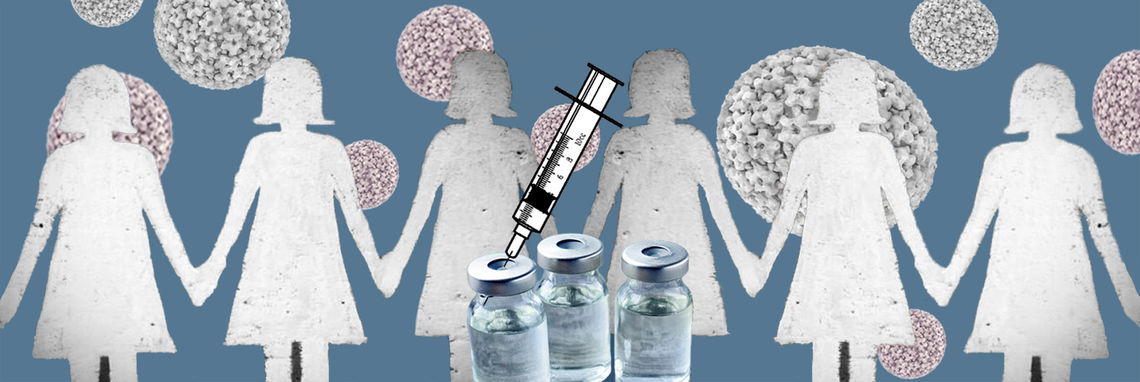
Late last year, Armenia’s Ministry of Health introduced the HPV vaccine for 13-year-old girls in Armenia. Obtained through GAVI (Global Alliance for Vaccines and Immunization), the vaccination program is part of an introductory HPV-vaccine demo within the country. Over the course of the next two years, 20,000 13-year-old girls from all eleven marzes (regions) of Armenia are to receive the vaccine free of charge before the Ministry of Health makes a decision for permanent implementation of the vaccine into the national plan.
Despite overwhelming scientific data and research touting the safety and efficacy of the vaccine, and despite Armenia’s already strong national vaccination program (it has been lauded by the World Health Organization and UNICEF as “one of the best performing programs in the EURO region, with coverage against most of the antigens being above 95 percent”), there has been a lot of misinformation surrounding the HPV vaccine program. From concerns that girls will be forcibly vaccinated, to concerns that the vaccine will lead to cancer and infertility, the implementation of the program and the vaccine itself has created hysteria among certain segments of the Armenian public.
HPV (Human Papillomavirus) is one of the most common sexually transmitted infections. In fact, almost every person who has sex (defined here as vaginal, anal, and oral sex) at some point in their lives receives the infection; with most becoming infected the first time they engage in sexual relations. This means it is possible to have only one partner and still get HPV. There are also more than 100 types of HPV, and most people with HPV do not experience or exhibit any symptoms—meaning many do not even know they are infected, and may be passing the disease along unwittingly. Indeed, one may even have an HPV infection if they show no symptoms, and their only sexual contact with an HPV-infected person happened many years ago. Since HPV is a virus, it remains in one’s cells for an indefinite period of time–usually in a latent state, though occasionally displaying symptoms. Most HPV infections are usually harmless and cleared naturally by the body’s immune system. However, there are certain types of HPV that lead to genital warts and types of cancer, and it is these cases that the HPV vaccination hopes to prevent.
HPV types 6 and 11 are the cause of 90 percent of genital warts, and HPV types 16 and 18 are the cause of 70 percent of cervical cancers. In fact, almost all cervical cancer cases (99 percent) are linked to infection with HPV. In Armenia specifically, cervical cancer is the second most common female cancer in women aged 15-44 years, and it is the second most common cause of cancer-related death in women aged 15-44. More broadly, cervical cancer ranks as the fifth leading cause of female cancer in Armenia, and it is the ninth leading cause of female cancer deaths in Armenia.The best way to treat cervical cancer is to prevent it, and the only way to do that is through vaccination, before one becomes infected with HPV in the first place (which is why the target group for receipt of the vaccine is young girls).
While leading global research centers and organizations claim that the HPV vaccine is as safe as it is effective, any vaccine, just like any medication, may have side effects.
When it comes to efficacy, HPV vaccines, and specifically the one chosen for distribution within Armenia, Gardasil quadrivalent (commonly known as simply “Gardasil,” not to be confused with the newer, less studied Gardasil 9), is extremely effective in preventing infection of the cervical cancer-causing HPV types 16 and 18. In fact, according to the National Cancer Institute of the United States (NCI), “in the trials that led to approval of Gardasil and Cervarix [another HPV vaccine brand], these vaccines were found to provide nearly 100 percent protection against persistent cervical infections with HPV types 16 and 18 and the cervical cell changes that these persistent infections can cause.” The NCI further reports that “widespread vaccination with Cervarix or Gardasil has the potential to reduce cervical cancer incidence around the world by as much as two-thirds... In addition, the vaccines can reduce the need for medical care, biopsies, and invasive procedures associated with follow-up from abnormal cervical screening, thus helping to reduce health care costs and anxieties related to follow-up procedures.” This is an important point for many Armenians, as 80 percent pay out-of-pocket for healthcare-related expenses.
While leading global research centers and organizations claim that the HPV vaccine is as safe as it is effective, any vaccine, just like any medication, may have side effects. However, most people who are vaccinated do not have any side effects at all. Varduhi Petrosyan, Dean of the School of Public Health at the American University of Armenia said that the HPV vaccine may present mild side effects. “Some people have syncopia, or they faint, but this is mainly because the girls are scared of the injections,” she explained.
The backlash and panic that ensued with the introduction of the vaccine was something that the government of Armenia predicted in its application for obtaining the vaccine from GAVI, writing in the application that “the experience from countries that introduced HPV vaccine earlier suggests that traditional communication strategies used by immunization programmes may not be sufficient.”
Petrosyan also noted that the rumors of the HPV vaccine causing cancer and infertility are not grounded in fact. There is no valid, scientific community-accepted data suggesting that the HPV vaccine will have an effect on future fertility for women. In fact, according to the Center for Disease Control and Prevention (CDC), “getting vaccinated and protecting against HPV-related cancers can help women and families have healthy pregnancies and healthy babies,” as there is a (rare) chance of passing HPV from mother to child during birth, and not getting the HPV vaccine means it is possible to contract HPV-related cancers, whose treatments (like surgery or chemotherapy) have the potential to lead to pregnancy complications or infertility.
Similarly there should be no cause for concern in terms of the HPV vaccine causing cancer. The vaccine does not contain any live virus. Nor does it contain a killed virus or DNA from the virus, so it cannot cause cancer or other HPV-related illnesses. The developers of the technology behind the HPV vaccine, members of the NCI, explain that “the current HPV vaccines are based on virus-like particles (VLPs) that are formed by HPV surface components. VLPs are not infectious, because they lack the virus’s DNA. However, they closely resemble the natural virus, and antibodies against the VLPs also have activity against the natural virus. The VLPs have been found to be strongly immunogenic, which means that they induce high levels of antibody production by the body. This makes the vaccines highly effective.” This means that when the vaccine is given, the VLPS stimulate the body to make antibodies that are the exact same antibodies created by the body had a real HPV virus been introduced. Thus, when the real HPV virus is finally introduced, the body already has antibodies created to prevent the virus from entering and infecting the cells.
In Armenia, there have been citations of unreliable and faulty scientific studies and data. In fact, the backlash and panic that ensued with the introduction of the vaccine was something that the government of Armenia predicted in its application for obtaining the vaccine from GAVI, writing in the application that “the experience from countries that introduced HPV vaccine earlier suggests that traditional communication strategies used by immunization programmes may not be sufficient.” The government had plans to introduce the vaccine to the public through “tailored messages and communications material and activities on cervical cancer, HPV infections, and HPV vaccine” in hopes of preventing the hysteria that shook other countries that attempted to implement it (nations like Romania and Kazakhstan, who ultimately had to abandon the vaccine, and nations like Denmark and Japan, who saw coverage drop significantly), ultimately, “the information about vaccine safety events in Kazakhstan, Denmark, and Japan has been broadly disseminated through the Internet, mass media, and social media in all countries of the region” – including Armenia.
Varduhi Petrosyan explained that much of the hysteria surrounding the HPV vaccine in Armenia is coming from sources who are citing non-credible studies. She related it back to the attempt to introduce flour fortification in Armenia. “People were bringing up individual studies that did not have strong methodology; that did not have strong sample size. This was for flour fortification and the same is happening for the HPV vaccination,” she said. In addition to discussing the issue with sample size in these studies, Ms. Petrosyan also touched upon many of the ways in which the articles being disseminated among the Armenian public are grounded in studies that did not perform controlled experiments, nor followed global scientific guidelines for conducting research. Petrosyan also referred to an article in Mediamax which did an investigation on many of these anti-vaccine reports. In addition to finding that many of the studies and articles in circulation among Armenians on this topic are grounded in experiments and research with faulty experimental methods, the article stated that these studies are criticized by the scientific community, as well as funded by biased individuals.
In the GAVI application, the government lays out their plan: “Parents will receive comprehensive information about HPV disease and HPV vaccine; based on this knowledge they will be able to make informed decisions regarding the vaccination of their daughters.Parents who decide not to vaccinate their girls will have an opportunity to inform the school nurse about this decision."
Many other experts also corroborate Petrosyan’s observations. Dr. Arin Balalian, for example, wrote an article addressing this spread of misinformation, ending his piece with a call to journalists and “discussion organizers to study the arguments and the professional qualifications of their authors before publishing those facts.” Marine Hovhannisyan, Dean of the Public Health Faculty of Yerevan State Medical University, Doctor of Medical Sciences, noted that “after the vaccine is introduced, [it is not like] research is over… Every year after the introduction of the vaccine, different clinical trials are conducted in order to exclude the negatives and not harm the public.” Indeed, the safety of the HPV vaccine is reviewed almost every year through controlled experiments and meta-analyses of the data produced that year. The Global Advisory Committee on Vaccine Safety (GACVS) began reviewing vaccine safety data in 2007, and continued in 2008, 2009, 2013, 2014, and 2015. An extract from a report of a GACVS meeting in June 2017, published in the WHO Weekly Epidemiological Record, discusses how the GACVS responded to concerns from countries like Denmark and Japan (as well as studies from other nations like the U.S. and France) by reviewing the data presented to the committee. Important to note is that the GACVS ended their report with the following warning: “There are now accumulated safety studies that include several million persons and which compare the risks for a wide range of health outcomes in vaccinated and unvaccinated subjects. However, despite the extensive safety data available for this vaccine, attention has continued to focus on spurious case reports and unsubstantiated allegations. The Committee continues to express concern that the ongoing unsubstantiated allegations have a demonstrable negative impact on vaccine coverage in a growing number of countries, and that this will result in real harm. While ongoing monitoring and collection of robust data are important to maintain confidence, one of the challenges associated with the continued generation of data is that artefacts will be observed, which could pose further challenges for communication when taken in haste, out of context, and in the absence of the overall body of evidence.”
Nevertheless, despite the spread of misinformation, the Republic of Armenia is still attempting to integrate the HPV vaccine in such a way that people are informed and girls protected. In their GAVI application, the government lays out their plan: “Parents of girls who attend schools will be informed about introduction of HPV vaccine and planned dates of administration of the first and the second doses of HPV vaccine at school meetings. Parents will receive comprehensive information about HPV disease and HPV vaccine; based on this knowledge they will be able to make informed decisions regarding the vaccination of their daughters. Parents who decide not to vaccinate their girls will have an opportunity to inform the school nurse about this decision. The school nurse and GPs from health care facilities will follow up with these parents to ensure that they understand the risks and benefits of HPV vaccination.”
According to Armenia’s government, parents will ultimately decide whether to allow their daughters to be vaccinated.



